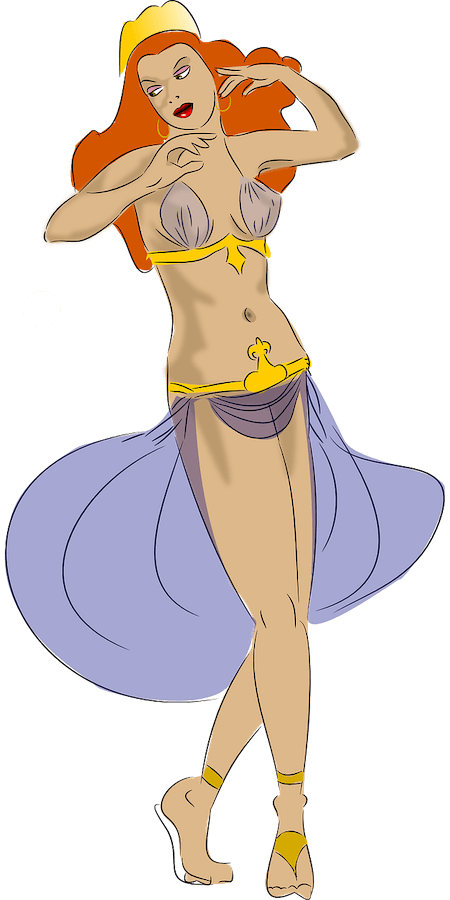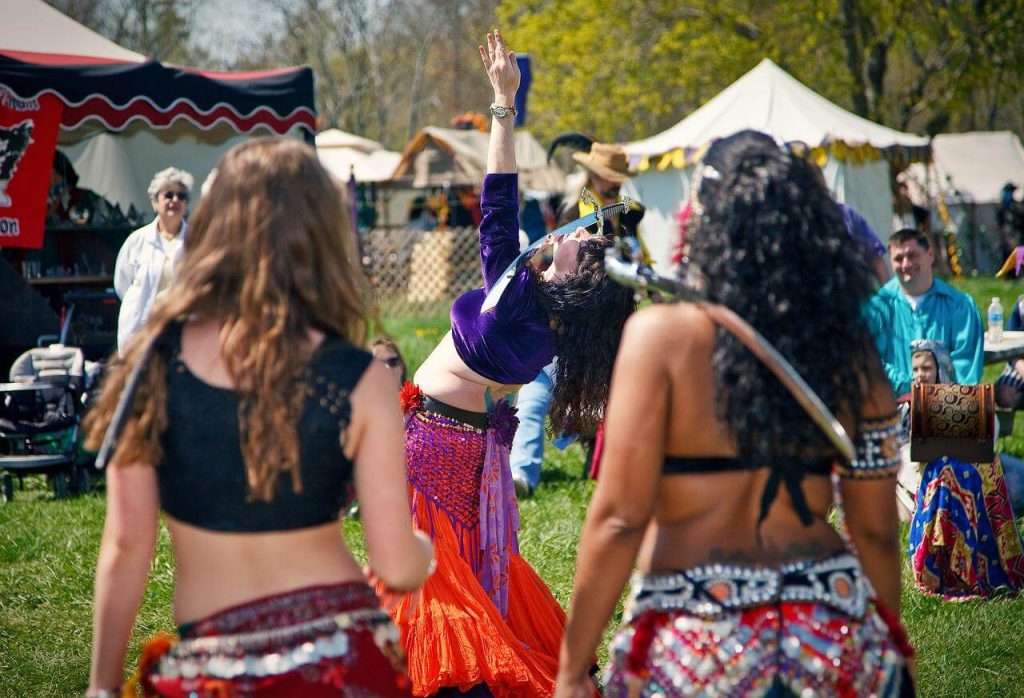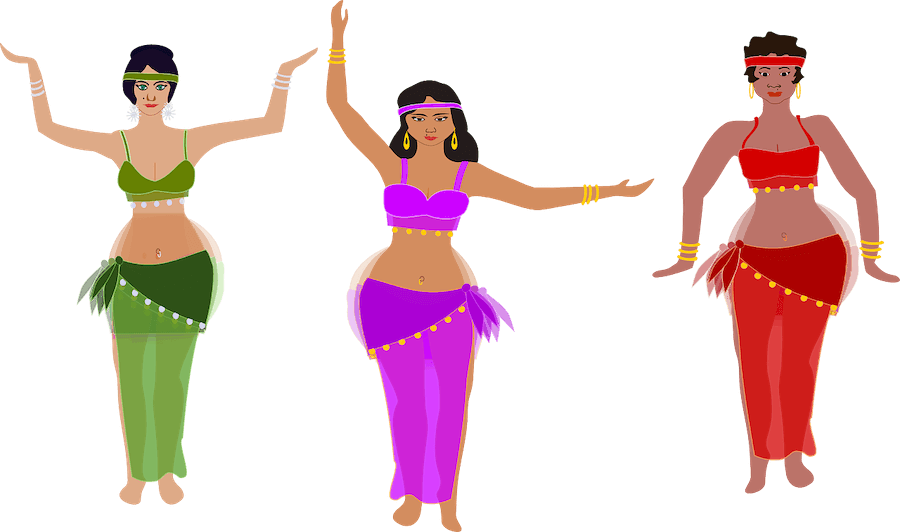The Basics – Hip Movements
When you begin any new exercise, it’s good to know what some of the basic terms mean. After all, if you’d never played football before, you might be puzzled about what dribbling meant, and when you start playing cricket, you need to know what they mean by googlies, fine legs and inswingers. The same is true in belly dance. All the characteristic dance steps have been given names. Knowing these names can help a lot if you’re trying to learn belly dance online or through books, and it can also help if you’re trying to plan some choreography. It’s also great if you’re dancing in a group extempore, as you can call out moves to each other and you all know what you mean.
Here, I’ve put together a list of some of the more common names (in English!) used to describe the different key moves of belly dance – along with a few tips and pointers that may help you learn how to do them (although it’s great to know what they look like as well). This article just looks at the hip moves (remember Shakira’s awesome hip moves?) – which are the most important ones to master in belly dance, but not the only ones.
Hip Circles
What is it? Also known as hip rolls, this is one of the first moves to master. Your pelvis makes a circle on the horizontal plane (as if you were drawing a circle on the ground). Think of powering a hula hoop.
How do you do it? Keep your feet grounded (for the basics) and your knees with a soft bend rather than locked. Now use your hip, thigh and abdominal muscles to shift your centre of gravity (which is in your pelvis) to the right, then forwards, to the left and back (or left–back–right–round). Once you’ve got the general feel of it, make those movements bigger and don’t be shy about it.

Variations: As the hip circle is such a foundational move, it has lots of variations. Add some vertical movement by bending the knees as you rotate your hips round and round. You can also keep one foot grounded and shift the other so you spin on your axis to face in different directions.
Basic Shimmies
What is it? A fast-moving shake of the hips from side to side.
How do you do it? Again, start with the knees soft rather than locked and both feet grounded. Keeping your feet grounded, bend one knee more and straighten the other. Notice how the hip opposite the bent knee pops out to one side. Now reverse, bending the other knee and letting your other hip pop out. Once you’ve mastered the basic feeling of popping your hips left and right, increase the speed. It gets intense! Wearing a coin belt helps you hear how fast your shimmy is going.
Variations: Advanced belly dancers can layer a shimmy over another move such as a hip circle or figure eight.

Hip Pistons
What is it? Also known as hip pops or hip bumps. A hip piston drives one hip out sharply to one side.
How do you do it? Feet grounded and knees loose, as usual. Now bend one knee and straighten the other, letting your hip pop to one side (yes, just like when you start with the basic shimmy). Imagine that you need to push a door closed when your hands are full and you can only use your hips. You can do this sharply (think of closing a car door) or smoothly (sliding a drawer closed)
Variations: You can play around with the size of the piston, and sharp versus smooth movements, or you can try to go out smoothly and make the return to the centre sharp.
Hip Lifts
What is it? These are typical of the Turkish belly dance style. One hip bounces up sharply.
How do you do it? Let’s say you want to do a hip lift on the right. Keep your left foot planted and shift all your weight onto it. Now, raise your right hip sharply – do this mostly using your side abdominal muscles rather than the muscles of your right leg (although your right heel will rise off the floor).
Hip Drops
What is it? These are the reverse of the hip lift, and involve one hip lifting slightly then dropping below its normal level – or just dropping.
How do you do it? This time, let’s try dropping the left hip. Shift your weight onto the right leg. Gently use your side abdominals to lift the left hip slightly, then drop it down heavily, as if you’re trying to use your hip as a hammer.
Variations: Add a little kick forward to the hip drop – or every second drop. This looks best if your body is angled side-on or three-quarters to the audience – or the mirror. If you’re dropping on your left hip, start with your left knee bent and your left heel raised. As your left hip comes down, kick your left foot forward with an elegantly pointed toe.
Figure Eights
What is it? There are three types of figure-eight hip movements, known as Turkish figure eights, Egyptian (inward) figure eights and Maya (outward) figure eights. The Turkish ones are the easiest, and the figure-eight is made on the horizontal plane. For the Egyptian figure eight, the top of each hip travels diagonally downward to the centre. For Maya figure eights, the motion moves diagonally upwards away from the centre. These last two are easier to picture if you see someone doing them!

How do you do it?
Turkish figure eights: Imagine that you can draw with the centre of your pelvis (if it helps, you can picture your vajayjay as a laser pointer or sparkler on bonfire night – works for some dancers, I know!). Now draw a figure eight or an infinity symbol on the ground by shifting your weight from hip to hip. If you’ve mastered hip circles in both directions, this should be straightforward, as it’s a combination of the two directions.
Inward figure eights: For this, let’s imagine that you have two sparklers or laser pointers facing the wall in front of you, one on each hip bone. Start by taking your weight on your left leg, then shift your right hip to the side. Bring that hip up, then imagine you’re drawing a circle with your laser pointer that curves from the top of the circle then down anticlockwise towards the centre. Once you complete the circle, shift your weight to your right leg and draw a clockwise circle with your left hip.
Maya figure eights: This movement is similar to the inward figure eight, but your right hip will draw a clockwise circle and your left hip will draw an anticlockwise circle. One dancer I know suggests imagining your pelvis as a goblet or cup. Now imagine honey or melted chocolate welling up spilling out of that goblet to the side. Trace the flow of that sweetness with one hip, then the other. Mostly use your abdominal muscles for this, but let your legs do some of the work from below.
Variations: The first variation is one you can use while learning the inward and Maya figure eights: just doing half of the move and drawing one circle on that wall with one hip. When you get more experience under your belly dancer’s coin belt, you can try doing the Maya without lifting your heels from the floor, or layering a shimmy over a Turkish figure eight.
Three-Quarter Shimmy
What is it? This is a cross between the classic shimmy and the hip lift. It’s considered to be an intermediate level to advanced move, so make sure you can do these two moves first.
How to do it? Start slow and break the movement down without music when you’re learning it, then speed up to the music’s tempo as you get the feel of it. Start by bending your right knee to pop your left hip out to the side. Now lift and drop that left hip. Then bend that left knee to shift your weight and let your right hip pop out. Right hip up and down. The lift and drop should be very quick. It’s tricky to master, but once you’ve taught your muscles how to do it, it becomes instinctive.
